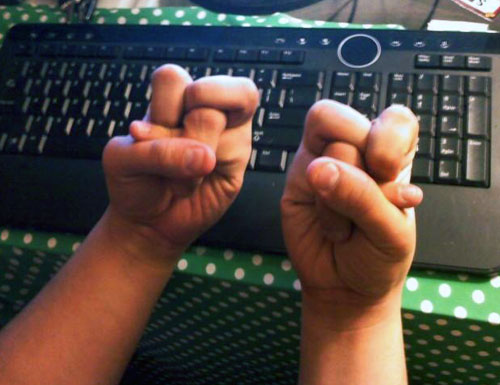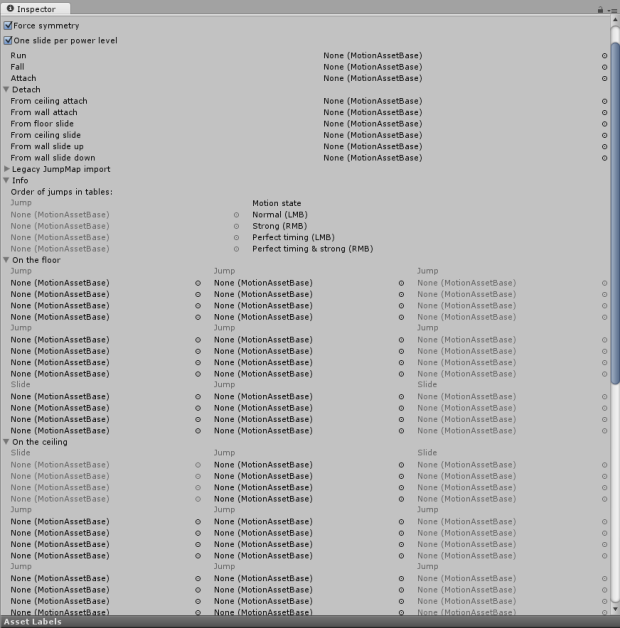Today was fun. I put together 5 levels, waited for a lunch break and ambushed several co-workers. I watched them closely as they suffered through the finger-breaking challenges.
The purpose of this test was to determine if my core feature – the controls system – has the right to exist or it should be revised.
The first victim was discouraging. He had lots of problems as he could not see the basic logic behind what defines the jump. And even if he did try to do the right thing he failed miserably. It was a torture, not only for his fingers and ego, but for my eyes and confidence as a game designer. Not really surprising, considering that he’s not into platformers, but still demoralizing.
He said that it was kinda fun, but I know, for him it was not.
I approached my second victim with bad expectation, but there was still hope – I knew he’s a masochistic Super Meat Boy-and-like fan. Right away he started to experiment muttering “oh, I see” every 2 seconds. In just 15 seconds he got more understanding of the game than my first prey. He was good. Not in a way “he does stuff the way I expect him to do” but rather in a “I have a plan and I will stick to it and I will improve my skill” way. Yes, he chose actions I’d never say are obvious (and they are like 5 times tougher to pull off than the “optimal route” I planned), but he never got discouraged (despite or because of swearing A LOT). He obviously had fun during those 5 levels, and I had fun watching him suffer \ play.
When he was done with what I had to throw at him I showed him “the supposed way to pass some challenges” and we shared a laugh. “I love to come up with absurd solutions and succeed with them”, he said not without pride.
The good news is that as soon as he grasped the principle the controls work, he became pretty excited about it and totally made my day.
The third playtest was not planned, but my colleague saw us playing and got curious (poor fella), so I decided to collect more data. Well, he did weird. He struggled with the most basic moves, but easily completed several rather hard chains of moves. The internal logic of the controls was a mystery for quite some time and by the 3rd level I thought he would quit. But at the level 4 there was some sort of “eureka” moment and I could feel the enjoyment (and understanding) level rise. In terms of positive (for game, not my ego) feedback he was the most helpful one – I spotted several places to improve level design and to better convey the basic controls principle (and yes, I want players to experiment and find stuff “on their own” rather than to feed them info with a tutorial).

This violet thingie says “experiment”, but noone seems to understand / care / try to do so. On a side note – on this picture you can see like 60% of the level and it really takes practice to complete it.
Oh, by the way, this last dude is no stranger to platformers, but not as hardcore as Super Meat Boy. So that means I’m pretty much in the place I wanted to be, as I was making a game inspired by Team Meat’s SMB.
Anyway, my worst fear that the core feature would not be understood, to some degree, was confirmed. Good news is that the problem seems to be not in the system itself, but in the fact that I do poor job at giving players right hints. As long as I find the way to better communicate it, I should be fine.
Also, what I’ve found out is that people choose anything but what expected them to. Of course I knew it would be so, but I could not imagine in what ways this phenomenon would translate to an SMB-like platformer. And I did design most of the levels in a way that allow some deviations, I just thought they were smaller.
Another fun observation – even if there is an explicit directive to experiment, people tend to think of one plan and stick with it even if it obviously does not work until it starts to work.
Also, it seems to have little to no use to watch someone else play. That third tester observed the second one for some time, but he made lots of the same mistakes (and lots of his own) regardless. Just a fun observation. =)
This game is supposed to be difficult. I want players to jump right at the edge of the cliff. And I expect them to time their actions. It is not simple and it was usually the reason my testers died. However not all deaths were resulted in their inability to do so – obviously I made several mistakes in level design. It’s a good thing I now know them now and I will fix them ASAP (probably today).
Although the game IS supposed to be challenging and I expect players to die like 10 times on each level, I looks like that ATM I’ve made it a bit too tough.

“WTF am I supposed to do?!?!?!? and HOW did I just do it?!?!?” seems like the most natural reaction in this situation. FYU you can’t just run under those spikes and you cant just jump over that small spike-hill…
So what’s next?
Fix the levels, think of a better way to explain the controls without actual explaining, and test again. Sadly I won’t be able to use the same people (unless I test new levels), so I’ll have to find someone else, like you. But I feel wrong showing only 5 levels, so it might take some time. Also there are some things I am uncomfortable with (like the fact that the game still has no name), so they need to be fixed.
On a side note, if you wonder how big\small one level is, think of SMB. They are approximately the same.
Anyway, if you like challenging platformers you might consider warming up your fingers and prepping extra keyboard.
Tweet, share, comment. You now how it works =)











